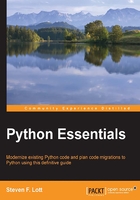
Summary
We've looked at installing or upgrading Python so that we can work with version 3.3 or 3.4, and we've looked briefly at the minor differences between Windows, Mac OS X, and Linux. The principle difference among the OS variants is that Windows lacks Python, whereas Mac OS X and Linux generally have a version of Python already installed. There are few other differences among the operating systems.
We've looked at some basic interactions using the REPL. We looked at some simple expressions and the built-in help() subsystem.
We've looked at some ways that the import statement extends the basic capabilities of our Python runtime environment, and we've also introduced the larger Python ecosystem. We can add to our Python library using the pip (and easy_install) tool. The PyPI is the central repository for most of the Python extension modules.
In the next chapter, we'll look at Python's numeric types in detail. Python numbers form a kind of "tower" that follows the mathematical notions of integer, rational, real, and complex numbers. We'll look at the mathematical operators and some of the standard libraries for working with numbers.
We'll also look at some of the more complex data types available, including/alongside specific tuples, strings, and frozensets. These are relatively simple because they are immutable. As is the case with ordinary numbers, the values of these more complex objects don't change either.